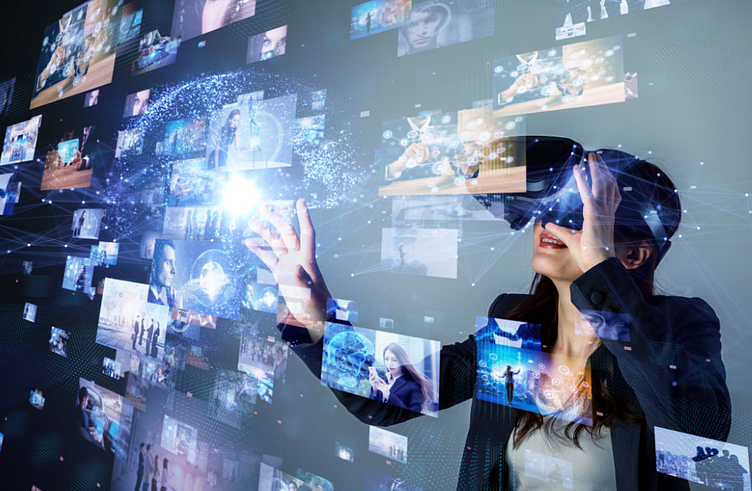How AR is Reshaping the Landscape of Digital Marketing
Augmented Reality (AR) is significantly reshaping the landscape of digital marketing by offering new and innovative ways for brands to engage with consumers. Here’s how AR is digital marketing transforming:
1. Immersive Product Experiences
Virtual Try-Ons: AR enables customers to virtually try on products like clothing, accessories, and makeup, providing a more personalized shopping experience. This reduces the uncertainty of online shopping, leading to higher conversion rates.
3D Product Visualization: Consumers can use AR to visualize products in their real-world environment, such as seeing how a piece of furniture would fit in their home. This helps in making informed purchasing decisions.
2. Enhanced Customer Engagement
Interactive Advertising: AR turns traditional ads into interactive experiences. For instance, users can scan a QR code or an image to unlock 3D animations, videos, or games, leading to higher engagement rates.
Gamification: Brands are using AR to gamify their marketing campaigns, such as creating AR treasure hunts or challenges that reward users with discounts or prizes, driving user participation and brand loyalty.
3. Personalized Marketing
Customized Content: AR allows marketers to deliver personalized experiences based on user data and preferences. For example, an AR app might suggest products that complement what a user has previously purchased or shown interest in.
Location-Based Marketing: AR can offer location-specific promotions or experiences, such as a retail store providing AR-based discounts when a customer enters the store or an AR map that leads customers to the nearest outlet.
4. Innovative Storytelling
Brand Storytelling: AR enables brands to tell their stories in more engaging ways. For example, a brand might use AR to show the journey of a product from production to the consumer, or bring a mascot to life to interact with users in their environment.
Augmented Print Media: By scanning a printed ad or brochure with a smartphone, users can unlock AR content like 3D models, videos, or interactive features, bridging the gap between print and digital marketing.
5. Increased Social Media Engagement
AR Filters and Lenses: Social media platforms like Instagram, Snapchat, and Facebook have integrated AR filters and lenses that allow users to interact with branded content in creative ways. These filters often go viral, increasing brand visibility and user engagement.
User-Generated Content: AR encourages users to create and share content featuring branded AR experiences, amplifying word-of-mouth marketing and expanding reach organically.
6. Real-Time Data and Insights
Consumer Behavior Analysis: AR provides real-time data on how users interact with digital elements, allowing marketers to analyze consumer behavior more accurately and refine their strategies based on these insights.
Feedback Loop: Brands can gather immediate feedback on new products or marketing campaigns through AR interactions, allowing for quicker adjustments and more targeted marketing efforts.
7. Cost-Effective and Sustainable Marketing
Reduction in Physical Samples: AR reduces the need for physical samples by offering virtual alternatives, such as virtual product try-ons or 3D product demos. This not only cuts costs but also supports sustainable marketing practices by reducing waste.
Scalable Campaigns: AR campaigns can be easily scaled across digital platforms, reaching a global audience without the need for extensive physical infrastructure or logistics.
8. Competitive Differentiation
Innovative Brand Identity: Brands that leverage AR are seen as innovative and forward-thinking, helping them stand out in competitive markets. This tech-savvy image attracts younger, more tech-oriented consumers.
Creating Unique Experiences: AR allows brands to offer experiences that are difficult to replicate, creating a unique selling proposition (USP) that differentiates them from competitors.
9. Boosting Customer Loyalty
Loyalty Programs: AR can be integrated into loyalty programs to offer exclusive experiences or rewards, encouraging repeat business and fostering long-term customer relationships.
Interactive Rewards: For example, customers might collect virtual points or rewards by interacting with Augmented Reality content, which can be redeemed for discounts or special offers.
10. AR-Powered In-Store Experiences
Virtual Shopping Assistants: In retail environments, AR can enhance the in-store experience by providing virtual shopping assistants that guide customers through the store, suggest products, or offer promotions based on their preferences.
Interactive Displays: Retailers are using AR to turn physical displays into interactive touchpoints where customers can learn more about products, watch demos, or access personalized recommendations.
Conclusion
Augmented reality is not just a passing trend in digital marketing; it’s a transformative force that’s reshaping how brands connect with consumers. By offering immersive, personalized, and interactive experiences, AR is setting new standards for customer engagement, storytelling, and brand differentiation. As AR technology continues to evolve, its impact on digital marketing is likely to grow, offering even more opportunities for innovation and customer connection.
